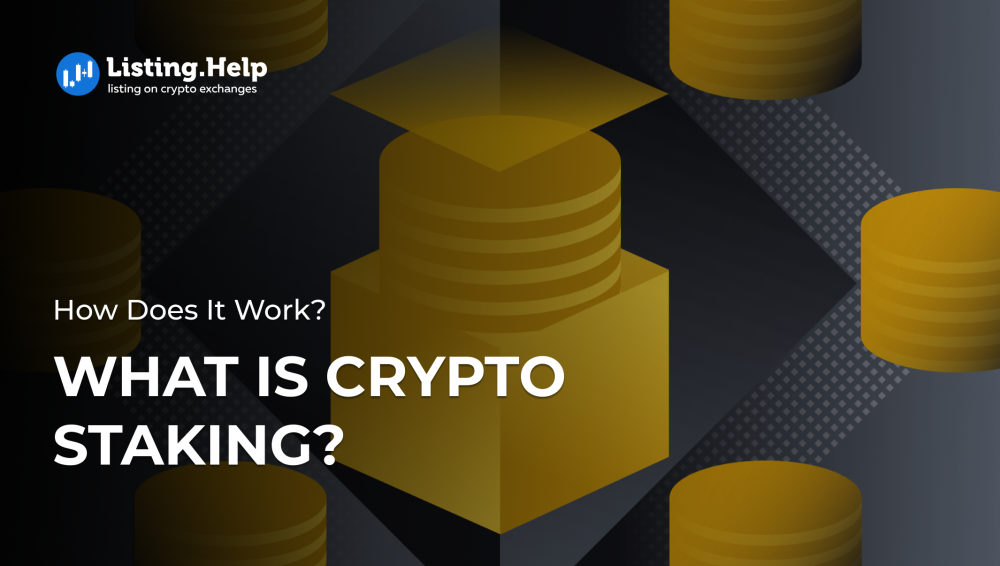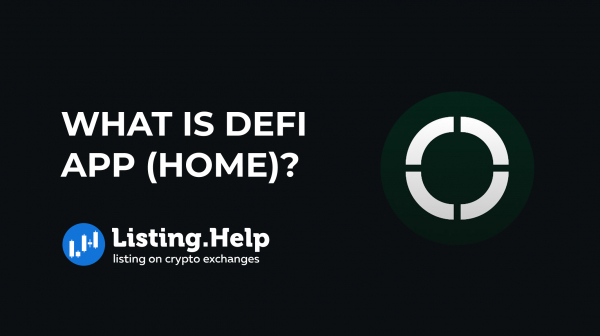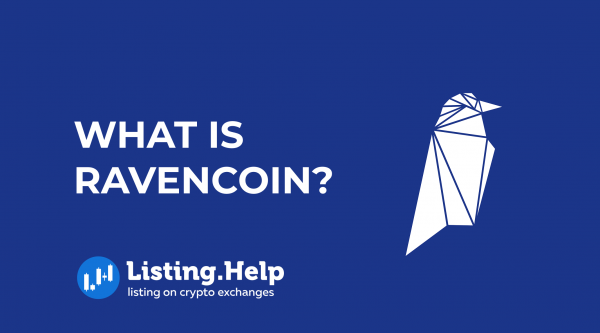What Is Crypto Staking, and How Does It Work?
 October 31, 2023
October 31, 2023 Updated: January 27 2025, 07:24
Updated: January 27 2025, 07:24
LEAVE A REQUEST
Launching your own token project? Our experts are ready to help with listing on exchanges, market making, marketing and other solutions
SUBMIT APPLICATIONStaking involves allocating a specific amount of cryptocurrency to aid in the maintenance and security of a blockchain system. By doing this, individuals are playing a pivotal role in verifying and adding transactions to the blockchain ledger.
This method is common in blockchain networks like Ethereum and Cardano that employ a proof-of-stake (PoS) framework. It’s different from the proof-of-work (PoW) mechanism, which is seen in Bitcoin and depends on mining via substantial computational power.
While staking provides opportunities for rewards, it limits the immediate availability of your cryptocurrency. While these assets can typically be retrieved, they’re often restricted from other activities until they’re withdrawn from the staking agreement.
How Does Blockchain Staking Work?
In the realm of PoS blockchain networks, there’s a designated staking currency. This is commonly the primary token on that blockchain. For instance, in Ethereum’s PoS blockchain, the staking currency is ether. If another PoS network emerges, it’s likely to have its own unique staking currency, which participants would need to secure to engage.
There’s no one-size-fits-all way to stake. It truly depends on the participant’s technical know-how, the amount they wish to stake, and their desired control level.
For the tech-savvy, establishing and overseeing a validator node on the blockchain might be the way to go. This offers maximum control but demands technical prowess, bearing the most accountability and potential hazards.
Alternatively, there are staking platforms that let individuals delegate their stake to an external service that manages the validator node. This middle-ground approach lets holders maintain some control, offloading the node management to a specialized provider. Another method is pooled staking, pooling your stake with that of others, which we can delve deeper into upon request.
Lastly, certain crypto exchanges extend staking facilities, enabling users to stake directly via their platform. This is undoubtedly the most user-friendly route. However, prior to committing, users must meticulously review the exchange’s security protocols.
Types of Staking
Proof of Stake (PoS): In the quest to find alternatives to the energy-intensive Proof of Work (PoW), Proof of Stake (PoS) emerged as a front-runner. Here, validators are chosen to craft new blocks and affirm transactions based on the magnitude of tokens they’ve staked relative to the network. These validators play a pivotal role in maintaining consensus across the network and are compensated via rewards and transaction fees. The stakes they provide act as collateral, discouraging malicious behavior, as any foul play may result in a penalty where tokens are confiscated. PoS stands out as it drastically cuts down on energy use, removing the need for resource-heavy calculations inherent to PoW. Furthermore, its design promotes broader participation as it negates the need for pricey mining gear. Consequently, PoS has garnered substantial attention, providing a greener, more inclusive approach to secure and streamline blockchain operations.
Delegated Proof of Stake (DPoS): DPoS, a subset of PoS, refines the consensus method further. It allows those with tokens to cast votes, selecting a handful of trusted entities – often termed ‘witnesses’ or ‘block producers’ – to be responsible for transaction validation and block creation. These chosen few are picked based on their credibility, technical acumen, and stake. By limiting the validation process to a select group, DPoS can handle a greater number of transactions promptly, catering to platforms that prioritize swift confirmations and scalability.
Variants of PoS: Several blockchain networks have devised their own consensus protocols, bearing semblance to PoS but with distinct nuances. Solana, for instance, employs Proof of History, while Avalanche banks on the Snow consensus protocol, and Cosmos Network incorporates Ignite (previously known as Tendermint). These platforms typically maintain validators and node managers, albeit under varied nomenclature.
Benefits of Staking
1. Passive Income Generation: Participation as nodes in the validation mechanism of networks leads to the acquisition of cryptocurrency or transaction fees. This offers an avenue for passive income. Moreover, it provides a means for users to make their idle assets productive, negating the need to liquidate them.
2. Bolstering Network Safety: The act of staking enhances the security of the network. Validators, by risking their own staked assets, have a tangible stake in ensuring the network’s integrity. Missteps or intentional misconduct can lead to a significant loss by having these stakes seized, thus acting as a strong deterrent against any nefarious intentions.
3. Upholding Network Decentralization: By opening the gates to anyone to act as validators, staking nurtures the decentralized nature of the network. This broad participation mitigates the threat of the network falling under the sway of a singular dominant entity, ensuring its safety and transparency.
4. Environmentally Conscious Approach: Compared to the power-hungry PoW mining systems, staking stands out as a far more sustainable choice. It circumvents the extensive computational demands, translating to a considerable reduction in energy consumption, thus being eco-friendly.
5. Influence over Network Evolution: Certain blockchain networks empower their staking participants with governance capabilities. These stakers can have their say in the introduction of modifications, enhancements, or protocol shifts, granting them an active role in steering the network’s trajectory.
Potential Risks of Staking
Engaging in crypto staking is not without its challenges. Validators should be thoroughly acquainted with the intricacies of the cryptocurrency they wish to support, the associated risks, and the technicalities of the staking process. Here are some hazards to consider:
1. Value Fluctuations: Cryptocurrencies are notorious for their price volatility. This means the worth of the staked assets can diminish swiftly, which could lead to notable financial setbacks.
2. Penalties for Missteps: In the realm of PoS networks, validators are at risk of incurring penalties if they breach the protocols of the network, such as committing to a double spend or having prolonged inactivity. This could lead to a reduction, or in severe cases, a complete forfeiture of the staked assets.
3. Concentration Concerns: Certain PoS systems might see a dominant chunk of staked coins held by a limited set of validators. Such a scenario can heighten centralization threats, where these predominant validators might wield excessive control over the network’s operations.
4. Technological Hurdles: The very act of staking demands that assets be secured in a specific digital wallet or on a validator node over long durations. If there are technical glitches or software anomalies, it might culminate in the loss of the staked assets.
5. Accessibility Constraints: Staking usually entails locking away assets for specified durations. During this window, users might face challenges in accessing their staked coins, potentially hindering their ability to capitalize on market trends or realign their investment strategies in response to market dynamics.
Rewards and Fees
In the realm of staking, two primary avenues for earning exist: staking rewards and transaction fees. Here’s a breakdown:
1. Staking Rewards: These are earnings allocated to participants who commit their digital assets to uphold the integrity of a blockchain network. The rewards a validator accrues are proportionate to the amount of cryptocurrency they’ve committed and the frequency of their validation efforts. Essentially, it’s a compensation mechanism to acknowledge their role in network maintenance. Validators are compensated in the native cryptocurrency of the platform they’re supporting.
2. Transaction Fees: Every cryptocurrency transaction incurs a fee, charged to the sender. This fee is then used to recompense validators for their validation services. The earnings from transaction fees a validator garners are in tandem with the volume of transactions they oversee.
Now, let’s touch on the grander picture. The staking sector boasts an impressive $315 billion market capitalization. Data from Staking Rewards reveals an average return rate of 7.29% across blockchains, translating to an annual revenue of over $23 billion sourced from staking activities. A noteworthy observation is the high staking rate with most blockchains clocking in between 40-70% of their total token supply committed to staking. Ethereum, transitioning into a PoS model, presents a stark contrast with only 17% of its supply staked as of July 2023. This suggests ample room for growth in Ethereum’s staking landscape.
What Is a Staking Pool?
Imagine a collective where cryptocurrency enthusiasts join forces, amalgamating their tokens to enhance their prospects of earning staking rewards. This collective is termed a “staking pool”.
In essence, a staking pool allows participants to merge their staking capacities. This amplified capacity heightens the likelihood of the pool being chosen as a validator, thereby securing rewards. These rewards are then apportioned among the pool’s members, dictated by each member’s individual contribution.
For many, the allure of a staking pool lies in sidestepping the intricacies of operating a validator node. Instead of navigating the technical maze, they can simply delegate their tokens to the pool and reap rewards.
Furthermore, not all holders possess a substantial stash of cryptocurrency. Staking pools present an avenue for these smaller stakeholders to still partake in staking. By aggregating their tokens with others, they can meet the threshold to participate and thus, garner rewards.
Yet, there’s a caveat. Pools usually levy a service fee, extracted from the collective’s earned rewards. Additionally, trust is paramount. Engaging with a staking pool demands due diligence, ensuring the pool’s credibility, operational history, and security protocols.
Conclusion
Engaging in cryptocurrency staking plays a pivotal role for those intent on contributing to the stability and governance of blockchain networks. Moreover, it provides a structured method to accrue benefits merely by retaining digital currencies. As the complexity of accessing the blockchain world diminishes, staking’s role becomes increasingly crucial.
Furthermore, to deepen your understanding and stay updated on such pivotal topics, I urge you to visit our dedicated blog at https://listing.help/blog.







 June 28, 2025
June 28, 2025 








